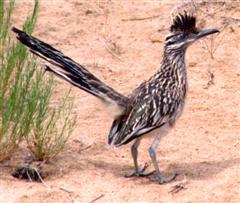Roadrunner
Chaparral Bird, Chaparral Cock Scientific Name: Geococcyx californicus
Sat, 19th July, 2025 - 2:56 am GMT
Sponsor Ads:

Alternative Name
Chaparral Bird, Chaparral Cock Scientific Name: Geococcyx californicusBasic Info
When full grown, a Roadrunner is about 22 inches long and has a long tail with graduating feathers. The tails are carried at an upward angle and are used for balance while running. Roadrunners are often about a foot high. Unlike other birds, Roadrunners usually excrete salt through their nasal glands rather than through their urinary tracts. Roadrunners have long bills, their feathers are mottled black and white and their tails have white tips. The Roadrunner is also characterized by a distinctive crest. Like all birds of the Cuckoo family, the Roadrunner has two forward facing toes and two backward facing toes. Its legs are strong and long. Its wings are short and rounded, and Roadrunners are too heavy to fly for long distances.
Health
Sometimes, Roadrunners will allow their body temperatures to drop during the night and can become as cold as 33 degrees Celsius. If a bird is incubating eggs, it will not let its body temperature drop! Breeding By the time they are between two and three years old, Roadrunners are sexually mature. Courtship consists of a dancing display by the male, who will feed the female. They mate in the spring, and a clutch may have between two and 12 eggs. Usually, these eggs will incubate for about 19 days and new clutches are laid yearly. By three weeks of age, Roadrunners are usually independent and in some areas, two clutches may be laid.Habitat
N/ABehavior
Once called the "Chaparral Bird", the Roadrunner has become popular in recent years through its comical cartoon representation, the Roadrunner, who continually eludes Wile E. Coyote! During the winter, Roadrunners will sometimes eat vegetation when food is scarce. Roadrunners are so fast that they can even eat hummingbirds that they steal from the air, and quick-striking rattlesnakes! They can also run at speeds of up to 17 miles per hour! These birds prefer to run rather than fly, and in desert areas of North America they may be a common sight, dashing across fields and roads. Generally, Roadrunners are found in desert scrubland or arid flatlands. When startled, it may take wing and fly for a short while. Roadrunners make cooing noises, usually about six or eight coos in succession, that lower in pitch. They can also make a chattering noise. When the sun is hottest, around mid day, the Roadrunner is less active. Roadrunners build shallow nests of sticks, usually locating them in bushes, cacti, or trees. Usually, they live between seven and eight years.Origin
North AmericaHistory
The Roadrunner is native to the southwestern United States and northern Mexico. It is also known as the Chaparral Cock. Roadrunners have disappeared from some parts of their ranges. Today, the Roadrunner is caricatured by a popular cartoon character, the adversary of a coyote, who continually outsmarts the animal!Common Foods
Roadrunners eat a number of lizards, snakes, scorpions, centipedes, mice, and insects. They will even eat Rattlesnakes! Eating meat allows the Roadrunner to extract a large amount of water from its food.Sponsor Ads:
I've begun to wonder if we wouldn't also regard spelunkers as desperate criminals if AT&T owned all the caves. -- John Perry Barlow
Roadrunner
Coded by: BGID® | ALL RIGHTS RESERVED Copyright © 2000-2025
Disclaimer | Privacy | Report Errors / Contact | Credits








 Preparing For China. China is growing their military. China Military Technology - can it keep up with the US?
Preparing For China. China is growing their military. China Military Technology - can it keep up with the US?  versus
versus 

 versus
versus 
 This Thread is about the North Korean Military itself - the kind of army, navy, and air force they have.
This Thread is about the North Korean Military itself - the kind of army, navy, and air force they have. 
 versus
versus 
 versus
versus  versus
versus